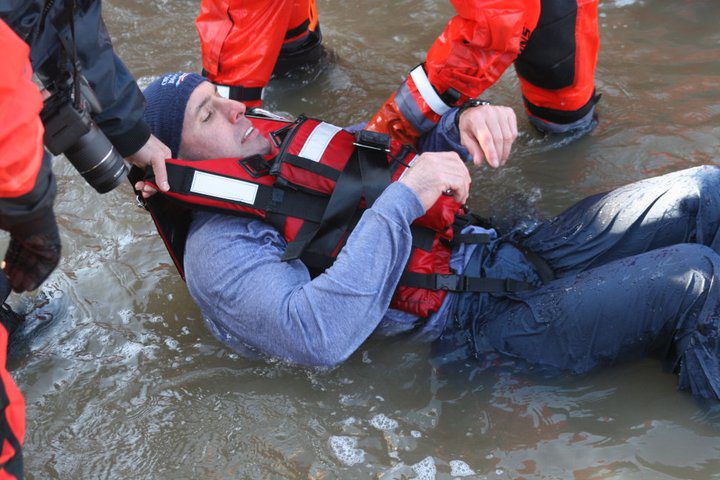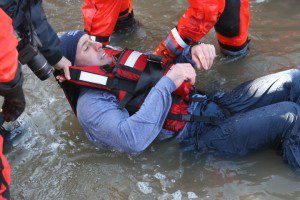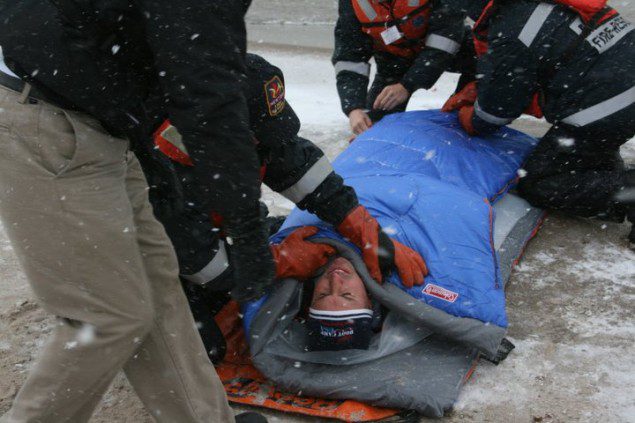The Harsh Reality of US Coast Guard Migrant Policy
by John Konrad (gCaptain) When merchant and cruise ships rescue migrants at sea, they offer more than just a lifeline from the perilous waters; they provide critical sustenance and care....




Beyond Boot Camp; Rescue, Recover, Rewarm – is a follow up DVD to Cold Water Boot Camp on the best techniques and practices used to safely recover hypothermic victims from cold water. My job? Easy. Get in the water and stay there until I am hypothermic. If you read my last article, then you know it will take at least an hour in the sub 40 degree lake to get my core temperature to drop that far. I sign the form and think one more time, “what the hell am I doing here?”
Two days later I’m lying on a stretcher, wrapped in a cocoon of blankets, violently shivering and in considerable pain. The water temp on lake Eerie had dropped to 32.6 – the effect freezing water has on your hands, feet, and other ….parts… is amazing. Dr. Gordon Geisbrecht – the project’s medical director and the world’s leading authority on environmental injury – had lowered the max immersion time (thanks Doc) to insure that the pain was not accompanied by real damage. Still, me and the other idiots who signed the release form were in considerable pain and discomfort. Looking up at the professional medics, firefighters, Coast Guard, and other municipal rescue workers ; I realized exactly what the hell I was doing there. We were all learning things.


It turns out that there are as many misconceptions about the treatment of hypothermia as there are myths about the condition itself, and if this project would help save lives like Cold Water Boot Camp did before it, then that was reason enough to be cold and wet just one more time.
The National Water Safety Congress released the DVD last winter, but I thought I’d share to gCaptain readers what we learned about caring for victims of accidental cold water immersion.
Important Note: What follows is advice about caring for victims pulled from cold water – specifically tailored for mariners at sea. This is because “at sea” is a place that often also means “hours, if not days, from a advanced care”. That makes “at sea” a much different place than say “at the marina – or beach” where professional medical assistance is nearby. As working mariners – the average gCaptain reader may need to handle victims from the water to full recovery – so this advice is for you.
Be careful getting them out: Approximately 20% of those that die from accidental cold water immersion – do so during the rescue phase. There are ways to get victims out of the water right and ways to do it very wrong. That’s because depending on a number of variables including time in the water, age, health, and half a dozen others – victims of cold water immersion may be in a very fragile physiological state.
Just being in water does things to the human body that change it. The pressure of the water on the limbs – particularly the legs (because they are deeper) – forces blood out of the legs and into the core and this raises blood pressure. When the water is cold, we get the added effect of constricting blood vessels in the outer skin layers and extremities (vasocontriction – see The Truth About Cold Water) and this also raises core blood pressure. The body is trying to keep the core warm and more blood in the core and less every where else helps.
Without digging in too deep – you should know that when a person spends long periods of time in cold water, they have changed physically. Their bodies contain warm blood and very cold blood; their heart has a decreased ability to speed up when it needs to, and veins and nervous systems have been temporarily altered in such a way that may have them on an edge very close to significant heart malfunction. They are fragile – and must be treated carefully: Here are some best practices for the recovery from the water phase:
Get Them Dry:
Just because you got them inside and out of the elements, doesn’t mean that they aren’t still cooling off. Wet clothes will continue to cool them off and hinder their recovery. Getting them dry sounds easy enough, but this is another area where there is a right way and a wrong way to do things:
To get an idea how being wet in a cold environment can effect the human body, watch this video shot during the first day of “Beyond Boot Camp”. This section was filmed to show rescuers how to remove a victim from the water and to a waiting ambulance. I was only in the water for a minute – but after exposure to the 24 degree air and blowing wind for just a few moments – my wet clothes really did a number on my ….comfort…the intense shivering is not an act.
http://www.youtube.com/watch?v=-w10WytDpFo
Keep Them Down
Now that they are dry and out of the elements – the recovery can begin. If they are intensely shivering, that’s good. But for those who have never seen it before, it is a little disconcerting. It looks awful and feels even worse, but it is just the body trying to regulate temperature. What I can tell you from experience is that the first ten minutes out of the water is far more painful than any ten minutes in it – but that if they are down and dry and shivering – things are looking very good. What you want to do next is help them….wait for it…keep shivering
Get Them Calories:
If your recovered victim has been in the water long enough to be shivering violently, then they have been burning an awful lot of calories. Depending on when they last ate, they may be running low on available fuel and need a boost. Knowing that, what do you think is better for your freezing – shivering – crew member; a warm cup of water, or an icy cold soda? (pick the soda) A warm sugary cocoa is better, but the point is that calories are more important than the temperature of the drink. They need the calories to fuel the shivering until they are fully recovered.
Warm Them Up (maybe):
There are many methods and devices for adding heat to help rewarm hypothermic victims. They range from complex medical devices like warm air infused blankets to simple heat packs or hot water bottles. But if it was my ships hospital, I’d just make sure I had a simple heating blanket. Put on low to medium they will provide radiating heat and everyone knows how to use them. Forced air systems have lots of parts to go bad, and heat packs can cause problems – even blistering – if they stay in contact with very cold skin. Simply cranking the heat up in the cabin is another way to assist in recovery. A warm bath or shower may seem like a good idea, but it isn’t. Remember, the blood in their skin will be cold and not moving for a while. What feels warm to you may be scolding hot to them.
One of my favorite myths about treatment is the old “climb in the sleeping bag with them” idea. Don’t – do not – back off. That may be a good idea to stay warm but not a good idea to re-warm a victim of cold immersion. They do not need anyone pressing up against their cold skin and agitating their cold muscles.
Watch Them:
People recovering from cold water immersion can look miserable. Their skin may be a red like a bad sunburn, they can shake violently, and they just sound like they are in pain – and they are. But here is the thing: If you have done everything above and they are red and shivering and complaining about how miserable they are – they are probably just fine. They are as uncomfortable as they have ever been in their lives, sure, but they are fine. All you can do is let them lay there and get over it. Just watch them until they are absolutely bored from laying there. None of this “get back to work” stuff until hours have passed. Of course, contact your medical authority and pass all pertinent information for recommendations. Did they injest or inhale sea water? If they did, it can cause problems unrelated to the cold that may require a medevac just the same.
Continued Training:
To view the entire video series from Beyond Cold Water Boot Camp, USA – or to order the DVDs for use as a training tool at sea, please visit www.coldwaterbootcampusa.org. Though produced primarily for professional medics and rescuers – the series is full of useful advice for anyone who works on or near the water.
Disclaimer: The views and opinions expressed by the author are not necessarily those of the Department of Homeland Security or the U.S. Coast Guard.
Join the gCaptain Club for curated content, insider opinions, and vibrant community discussions.


Join the 107,104 members that receive our newsletter.
Have a news tip? Let us know.
Access exclusive insights, engage in vibrant discussions, and gain perspectives from our CEO.
Sign Up




Maritime and offshore news trusted by our 107,104 members delivered daily straight to your inbox.



Essential news coupled with the finest maritime content sourced from across the globe.
Sign Up